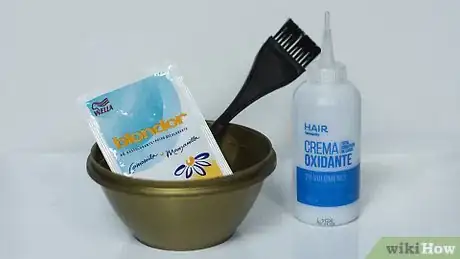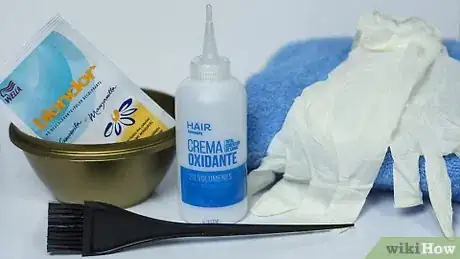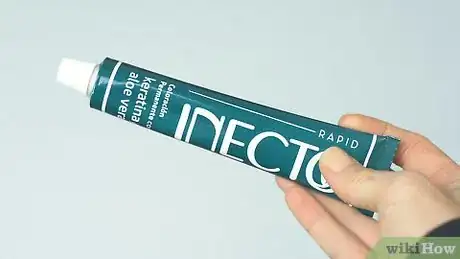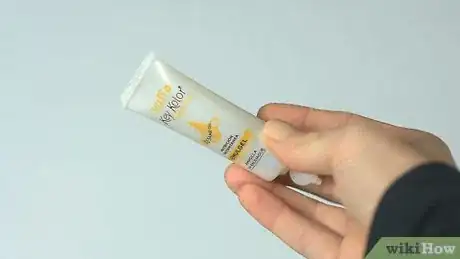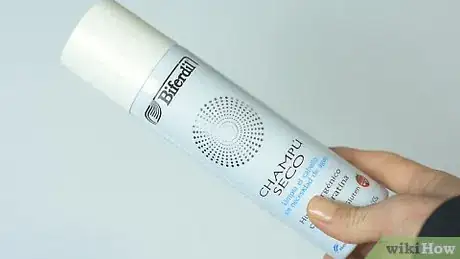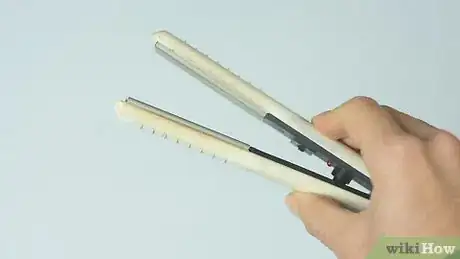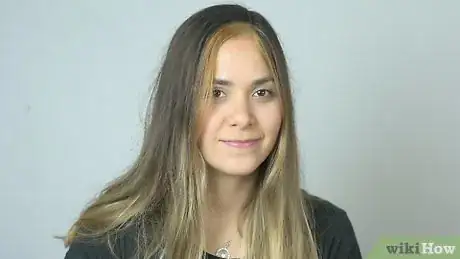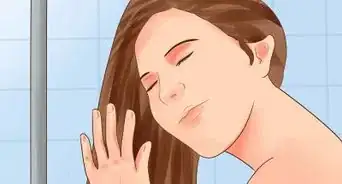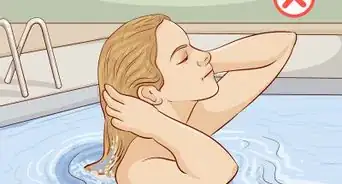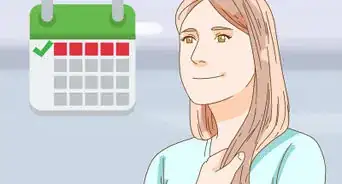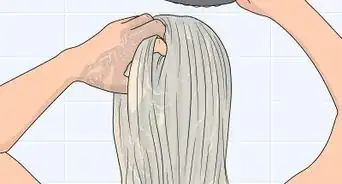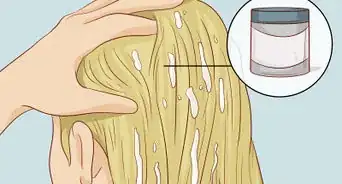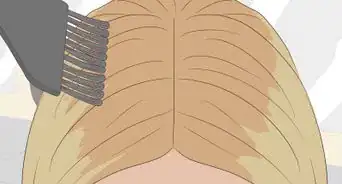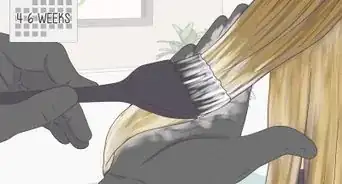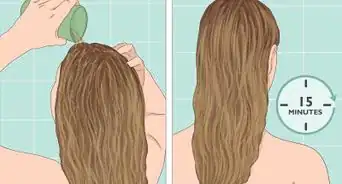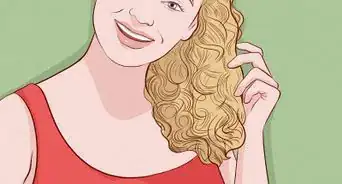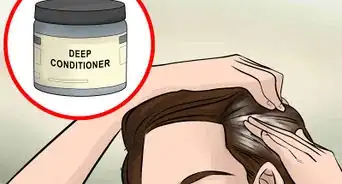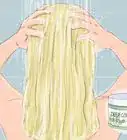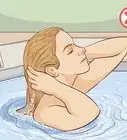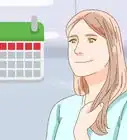This article was co-authored by Arthur Sebastian. Arthur Sebastian is the Owner of Arthur Sebastian Hair Salon in San Francisco, California. Arthur has worked as a hair stylist for over 20 years and received his Cosmetology License in 1998. He believes that the true work of a successful hair stylist comes from passion and a love for hairdressing.
There are 10 references cited in this article, which can be found at the bottom of the page.
This article has been viewed 107,548 times.
If you want to lighten your currently dyed hair and go blonde, the only method that will be successful is to use bleach. In order to reduce the amount of damage to your hair, wait at least 8-10 weeks after you’ve dyed your hair before you attempt to bleach it. Regardless, no matter what bleaching product you use to lighten your hair, it will cause damage. However, there are a number of things you can do before and after you bleach your hair to lessen and even repair that damage.
Steps
Preparing Your Hair for Bleach
-
1Purchase an at-home hair bleaching kit from the store. Look for and purchase a bleaching kit that’s specifically designed for all-over bleaching, not just touch-ups or roots. You can buy a bleaching kit at a drugstore, some grocery stores, a beauty supply store, or online. If this is your first time bleaching your hair, you may want to purchase the kit at a beauty supply store where you can ask for assistance.[1]
- If your hair is below your shoulders, you may want to purchase 2 kits to ensure you have enough bleach for all of your hair.
- Read all of the instructions before starting to bleach your hair.
-
2Use a deep conditioning mask every night for a week before you bleach. Purchase a deep conditioning hair mask at a beauty supply store, pharmacy or drugstore, salon, or online. Apply the deep conditioning mask to your hair before you go to bed every night for a week before you bleach your hair. Wear a shower cap over your hair while you sleep, then wash your hair in the morning as normal.[2]
- Using a deep conditioning treatment in advance will help your hair retain moisture and help protect it against the harsh chemicals found in bleach.
Advertisement -
3Stop washing your hair a couple of days before bleaching. Two days before you plan to bleach your hair, stop the deep conditioning treatment at night and don’t wash your hair. The natural oils that build up on your hair will protect your scalp from the bleach and will help hold moisture inside your hair during the process.[3]
- During the time you’re not washing your hair, try to avoid using any heat styling products like a flat iron or blow dryer.
-
4Gather all your supplies in the bathroom before you begin. Make sure you have the bleaching kit with the instructions open and available. Also, make sure you have plastic or latex gloves to wear throughout the entire process. Ensure you have at least a couple of towels available that are either white or towels that you don’t mind damaging. Protect the area around your sink with a towel. Also, put a towel around your shoulders or wear an old shirt while applying the bleach.[4]
- Be careful not to get the bleach mixture on the wall, floor, or countertop. If you do, clean it off immediately.
- Ensure you have a hair coloring brush for this process. If one did not come with your kit, buy one separately at a beauty supply store, salon, or online.
-
5Divide your hair into multiple sections using a comb. You’re going to have to apply the bleach solution from the roots to the tips of your hair. In order to make it easier to apply, divide your hair into at least 4 sections. Divide your hair into left and right sections from the middle of your forehead to the middle of the nape of your neck. Then divide the left and right sections in half from the top of your ears to the top of your head. Hold each section up with a hair elastic or clip.[5]
- You’ll want to divide your hair into at least 4 sections, but you can divide it into even more sections if that feels more comfortable.
Mixing and Applying the Bleach Solution
-
1Mix the bleach powder and developer together as instructed. Follow the manufacturer’s instructions for mixing the bleach powder and the developer. In most kits, you’ll be provided with a bottle or container in which to mix the powder and developer. Once combined, put the mixture into an old bowl so it’s easier to pick up with the hair coloring brush.[6]
- Only mix one kit at a time.
- Put your plastic or latex gloves on before proceeding.
-
2Perform a strand test before you apply anything to your hair. Separate out a 1 in (2.5 cm) square section of your hair from the back of your head. Apply the bleaching mixture to that section of hair. Wait the instructed amount of time for the bleach to process, then use your hands to rinse off the bleach mixture. Check the results.[7]
- If the bleaching kit provided a range of time to leave the bleach on your hair, you may want to test what color you get after different amounts of time. Once you’ve achieved the color you want, you’ll know the exact time to leave the bleach on the rest of your hair.
- If the results do not turn out as you were expecting, stop. Pack everything back up and find another bleaching product to try.
-
3Apply the bleach mixture to the first section of hair. Select a section to start with and remove any clips or elastics holding that section up. Divide the section into 1 in (2.5 cm) wide strips (one at a time) using the pointy end of a comb. Apply the bleach solution to that strip of hair from root to tip. Move the completed strip aside and repeat the process until the entire section has been bleached.[8]
- Clip that section of hair back up once it’s been bleached.
-
4Repeat the bleaching process for your remaining sections of hair. Unclip one section at a time to apply the bleach mixture. Clip each section back up when completed. Mix the second bleaching kit if you run out of bleach mixture while applying it to your hair.[9]
- Put a plastic shower cap on your head once all sections are complete.
-
5Allow the bleach to process for the required amount of time. Follow the manufacturer’s instructions and/or your strand test to determine the length of time you need to leave the bleach on your hair in order to achieve the color you want. However, keep in mind that if you started with really dark hair, even the maximum amount of time may not lighten your hair enough in a single application. You may need to repeat the bleaching process in 1-2 weeks to achieve an even lighter result.[10]
- Be careful where you go while the bleach is on your hair. Don’t lean your head back against anything, even with a shower cap on, or you may damage your furniture.
-
6Rinse the bleach out of your hair with warm or hot water. Rinse the bleach out by bending over a sink and putting your head under the faucet. Or, rinse the bleach out by getting into the shower (which might be easier). Use whatever water temperature is comfortable. Once all of the bleach mixture is rinsed out of your hair, wash it with shampoo.[11]
- Your bleaching kit most likely came with a small packet of shampoo to use at this point.
- Make sure to rinse your shower, tub, tiles, and shower curtain after you’re finished to remove any leftover bleaching mixture so it doesn’t damage anything.
Preventing Brassiness with Toner
-
1Decide which type of toner you want to use on your hair. Bleach removes the previous color from your hair follicles. Typically, bleach is used to remove hair color before applying a new hair color; where the new color applies multiple tones to your hair to make it look natural. When using bleach to turn your hair blonde, the results will make your hair color look unnatural. In order to make the blonde color look more natural, you need to use a toner to offset the unnatural tones revealed by the bleach. There are 3 types of toners available: ammonia-based, shampoos, and dye. Only the dye needs to be applied immediately after the bleach. The others require you to wait at least a couple of days.[12]
- You can purchase any of these items at a beauty supply store, salon, or online.
-
2Determine which toner color will work best for you. Toner comes in a variety of colors, including purple (or violet), blue, and green. None of these toners dye your hair purple, blue, or green. Instead, each toner color cancels out another color that may be caused by bleaching your hair. If your hair ends up with a yellow color, you can offset the yellow with a purple toner in order to make your hair color look more natural.[13]
- If your hair ends up with an orange color, use a blue toner.
- If your hair ends up with a reddish color, use a green toner.
- If you’ve bleached your hair before, you may already know what results to expect and can purchase the toner in advance.
- If you’ve never bleached your hair before, you may need to wait a couple of days to determine which color of toner is needed based on your specific results.
-
3Apply a small amount of toner hair dye to your just-bleached hair. Apply the toner to your hair immediately while it’s still wet after you’ve rinsed out the bleach mixture and shampooed your hair. Mix 1–2 tsp (4.9–9.9 mL) of toner to 1⁄2–1 c (120–240 mL) of white-colored conditioner. Apply the conditioner to your hair and allow it to sit for 15-30 minutes before rinsing away.[14]
- While you can apply a toner hair dye immediately after bleaching, it doesn’t have to be applied right away.
- If you want to wait to apply the toner so you can select the right color, apply the toner using the conditioner method after shampooing your hair in the shower.
-
4Use an ammonia-based toner 2 days after you bleached your hair. Ammonia is very damaging to your hair and shouldn’t be used the same day that you bleached your hair (for best results). Wait a couple of days after you’ve bleached your hair before using it and don’t wash your hair within that time frame. Follow the instructions on the box of toner for the exact mixing and application instructions.[15]
- Ammonia-based toner usually comes with a bottle of the toner and a bottle of developer that have to be mixed together before using.
- Once mixed, the toner can be applied to your dry hair and left for about 30 minutes, then rinsed out.
-
5Wash your hair with a shampoo that contains colored pigments. Purchase and use a colored shampoo to tone your hair on a regular basis. A toner shampoo can be used several times a week and simply replaces your regular shampoo in the shower. Allow the shampoo to sit on your hair for 5-10 minutes before rinsing it out and applying conditioner.[16]
- You may need to try a couple of different brands of shampoo until you find the one that works best on your hair.
Taking Care of Your Bleached Hair
-
1Apply a bond repairing treatment to your bleached hair every week. Purchase a bond repairing treatment product for your hair at a beauty supply store or online. Use the treatment once a week after you’ve bleached your hair. Apply a palmful of the product, which is typically a cream or paste, to your damp hair and leave it on your hair for at least 30 minutes. Wash your hair as normal afterwards.[17]
- If possible, leave the bond repairing treatment product on your hair overnight to get the best results. Wear a shower cap on your head while sleeping.
-
2Avoid washing your hair with shampoo when possible. Shampoo, in general, will cause any type of hair color treatment to fade, even those labelled as ‘color-safe.’ Every so often, when washing your hair, don’t use shampoo. Simply rinse your hair and apply conditioner. Alternatively, use a dry shampoo product instead of wetting your hair.[18]
- You can purchase dry shampoo at a beauty supply store, a drugstore or pharmacy, a salon, or online.
- Dry shampoos come in a powder or spray. They do not require your hair to be wet.
-
3Limit the use of heat styling equipment when you can. Styling your hair with heat, whether it’s bleached or not, will damage your hair. Since bleaching your hair will dry it out and cause damage, you’ll want to avoid using heat on your bleached hair whenever possible to prevent your hair from becoming brittle and breaking.[19]
- When you do use heat to style your hair, keep it on the lowest temperature you can.
-
4Wait as long as possible between bleachings to protect your hair. Since bleaching products are harsh and will damage your hair, wait as long as possible between bleaching treatments to help protect your hair. For the best results, wait until your roots are just under 1 in (2.5 cm) long before bleaching them. It will normally take 4-6 weeks for your hair to grow this much.[20]
- You may want to use a root color spray product in-between bleaching treatments in order to make your roots appear the same color as the rest of your hair.
- Root color spray products apply an artificial color to your hair temporarily. They only last until you wash your hair; they are not permanent.
Expert Q&A
Did you know you can get expert answers for this article?
Unlock expert answers by supporting wikiHow
-
QuestionHow do I correct orange roots when I'm bleaching hair blonde?
 Arthur SebastianArthur Sebastian is the Owner of Arthur Sebastian Hair Salon in San Francisco, California. Arthur has worked as a hair stylist for over 20 years and received his Cosmetology License in 1998. He believes that the true work of a successful hair stylist comes from passion and a love for hairdressing.
Arthur SebastianArthur Sebastian is the Owner of Arthur Sebastian Hair Salon in San Francisco, California. Arthur has worked as a hair stylist for over 20 years and received his Cosmetology License in 1998. He believes that the true work of a successful hair stylist comes from passion and a love for hairdressing.
Professional Hair Stylist You want to create new highlights to lift the orange roots out and combine that blonde color on your roots, preferably by doing it in foils. This is especially important since you need adequate separation of each section. And then what you do is you lift that root from orange to blonde. What many people do in this situation is they make their shadow roots a few shades deeper or darker than the blonde hair. This is called a color meld and it can create a smooth transition.
You want to create new highlights to lift the orange roots out and combine that blonde color on your roots, preferably by doing it in foils. This is especially important since you need adequate separation of each section. And then what you do is you lift that root from orange to blonde. What many people do in this situation is they make their shadow roots a few shades deeper or darker than the blonde hair. This is called a color meld and it can create a smooth transition.
Things You’ll Need
Preparing Your Hair for Bleach
- At-home hair bleaching kit
- Deep conditioning mask
- Comb with pointy handle
- Hair clips or elastics
- Plastic or latex gloves
- Towels
- Old shirt
- Hair colouring brush
Mixing and Applying the Bleach Solution
- At-home hair bleaching kit
- Non-metal bowl
- Shower cap
- Warm or hot water
- Shampoo
Preventing Brassiness with Toner
- Toner
Taking Care of Your Bleached Hair
- Bond repairing treatment
- Dry shampoo (optional)
References
- ↑ https://www.mamamia.com.au/how-to-bleach-hair/
- ↑ https://www.naturallycurly.com/curlreading/home/5-steps-to-prep-your-hair-for-bleaching-si
- ↑ https://www.naturallycurly.com/curlreading/home/5-steps-to-prep-your-hair-for-bleaching-si
- ↑ https://www.vogue.co.uk/article/how-to-bleach-your-hair-like-a-pro
- ↑ https://www.mamamia.com.au/how-to-bleach-hair/
- ↑ https://www.mamamia.com.au/how-to-bleach-hair/
- ↑ https://www.schwarzkopf.com/en/hair-color/dye-blonde/coloring-your-hair-blonde.html
- ↑ Arthur Sebastian. Professional Hair Stylist. Expert Interview. 29 April 2019.
- ↑ Arthur Sebastian. Professional Hair Stylist. Expert Interview. 29 April 2019.
- ↑ https://www.vogue.co.uk/article/how-to-bleach-your-hair-like-a-pro
- ↑ https://www.mamamia.com.au/how-to-bleach-hair/
- ↑ https://bellatory.com/hair/DIY-Hair-What-is-Toner-and-How-Does-it-Work
- ↑ https://bellatory.com/hair/DIY-Hair-How-to-Use-Wella-Color-Charm-Toner
- ↑ https://bellatory.com/hair/DIY-Hair-What-is-Toner-and-How-Does-it-Work
- ↑ https://bellatory.com/hair/DIY-Hair-What-is-Toner-and-How-Does-it-Work
- ↑ https://bellatory.com/hair/DIY-Hair-What-is-Toner-and-How-Does-it-Work
- ↑ https://www.marieclaire.com/beauty/hair/a28599/how-to-go-platinum-blonde/
- ↑ https://www.mamamia.com.au/how-to-bleach-hair/
- ↑ https://golivexplore.com/golden-rules-keeping-bleached-hair-healthy/
- ↑ https://www.marieclaire.com/beauty/hair/a28599/how-to-go-platinum-blonde/
- ↑ https://www.mamamia.com.au/how-to-bleach-hair/
